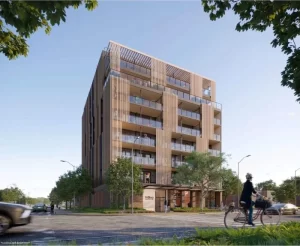Groups protest for and against planned Third Street shelter in New Toronto

Group against the location of the proposed shelter say it is a residential area with two schools and a seniors home. Photo CBC.
More than 100 anti-Third Street shelter braved the rain to protest on the site of the proposed facility that has split the community.
Protestors with signs filled the City parking lot, at 66 Third Street, where a planned 80-bed municipal shelter is planned.
Another group who were supporting the planned shelter said the homeless have to be housed somewhere, and the site was close to public transportation and social services.
Those opposed to the shelter in that location said it can be moved elsewhere.
They said the proposed shelter is close to a seniors residence and two schools in a residential area.
The planned shelter is one of 20 planned in different parts of the City to be completed by 2033.
The issue has created heated feelings in the community and a virtual town hall meeting with City officials is slated for April 15 from 7 p.m. to 8:30 p.m. You are asked to register as only 80 people can be accommodated.

The group New Toronto Initiative is calling for full public consultation on the location of the planned shelter.
A Go Fund Me page organized by New Toronto Initiative, a group of community members who are against the location of the facility, has raised almost $10,000 to fight the cause.
The group in its post said they believe in providing safe supporting housing for those in need.
“It’s important that this decision involves more thoughtful planning and community input to ensure the best outcome for both shelter clients and local residents,” it said.
The shelter is part of the city’s efforts to meet an unprecedented demand for shelter spaces. In addition to temporary housing, the facility will also provide access to other services such as harm reduction and mental health supports, and counsellors to help clients develop permanent housing plans.
Toronto Police Const. Reid retires from force to become a Baptist Minister
Former Toronto Police Const. Jonathan Reid has turned in his firearm and bullet proof vest for a Bible and a cross as a Baptist Minister.
Reid, 42, retired from the force March 26 after serving 17 years, mostly at 22 Division as a Community Neighbourhood Officer.
He knows the community well and said it was a tough decision to leave the force but he had to follow his calling.
“I have always been a religious person since an early age,” Reid says. “I always dreamed of being a police officer and I have done that. It’s time to do something else.”

Now Minister Jonathan Reid will be praying for his congregation on Sundays as well as conducting other pastorial work.
The former officer has been recognized by community members for his work with teens and helping them stay on track and out of trouble. He is credited by parents for helping their children stay in school and get an education.
He loves South Etobicoke, has patrolled certain areas by bike, and at one time took part in a program for teens at Franklin Horner Community Centre.
“ It’s all been through word of mouth,” Reid says. “I will miss the comradery with my former co-workers.”
Reid said he will miss helping people as a police officer, but now he can help them spiritually and in other ways.
In his new role, he will be an Assistant Pastor at the Cornerstone Baptist Tabernacle, at Blackthorn Avenue, in Toronto.
“I will still be working with youths in different programs but in a different capacity,” he insists.
His new job will have him conducting home visits, counselling and speaking to congregation members and hosting pray services on Sundays.
He was born in Toronto after his parents emigrated here from Barbados.
Long Branch parent Sandy Donald said Reid was able to provide guidance to his son during a rough time.
“He has helped my son, who considers him a friend,” Donald said. “Jonathan has helped many teens with issues in the community.”
Another young man, named Bernard, described Reid as ‘an honest officer who has helped him in times of trouble.’
Reid has spoken to students at many South Etobicoke schools as a policeman and his name gets passed around by students.
Reid advises students who want to become police officers to stay in school and get a high school diploma, stay out of crime and know what they want in the long-term and go for it.
Friends rallying on Go Fund Me to help senior who lost everything in house fire

Grandpa Jack with his dog Jack are lucky to be alive after an apartment fire. A Go Fund Me page has been created to help them.
Family and friends are rallying to help a 77-year-old New Toronto senior who lost all his belongs including a pet cat in a devastating apartment fire.
Jack MacDonald, who is affectionately known as ‘Grandpa ,’ is lucky to be alive after a his ground floor apartment at William Punnett Housing Co-op, at 3077 Lake Shore Blvd. W., went up in flames on March 24.
He “sadly lost nearly everything in the blaze,” according to the Go Fund Me page. “His neighbours are now coming together to support him in its aftermath.”
The senior, who is a long-time resident of the co-op, lost his beloved cat Smokey in the fire, in addition to his clothes, furniture, family photos and memorabilia.
Jack and his dog, also named Jack, are dubbed ‘Double Jack,” by many in the community.
“They are valuable members of our community, helping with maintenance throughout the co-op and putting a smile on everyone’s face,” according to organizer Essie Patcheson. He “has long been a positive and giving member of our community, who now needs our support.”
Jack lost his wife, who was his best friend in 2021. He had recently retired from working in the moving industry.
Patcheson said Jack has minimal insurance coverage and cannot afford to purchase new possessions. All he has left are the clothes on his back.
She said he will require help in paying for temporary accommodations, basic cooking supplies, furniture, linens, towels, food, and medical necessities for both Jacks.
“Any donation is greatly appreciated and will be used to help Jack pay for the items listed above as he navigates this very traumatic experience.”
Donations can be made by searching Go Fund Me.
It will cost taxpayers $1 million for Councillors’ 24% pay raise

Councillor Stephen Holyday is one of eight councillors who opposed the hefty pay increase for his colleagues.
Etobicoke Centre Councillor Stephen Holyday was one of eight who opposed a whopping 24 per cent pay raise as the City grapples for more funding.
The pay raise and benefits for Councillors adds almost $1 million to City coffers despite a huge $1.8 billion deficit that led to an eight per cent property tax increase.
The increase that was approved by Council 15 to 8 on March 27 will see the wages of councillors jump to a whopping $170,588 annually from $137,537.

Mayor Olivia Chow described the pay raise as ‘steep.’ She was not eligible for an increase on her $225,000 annual salary.
Holyday said he opposed the pay increase because he doesn’t think it’s appropriate.
“I just believe that, if we do this, it further erodes people’s confidence in government. And I don’t think we should do it,” Holyday said.
The increase does not apply to Mayor Olivia Chow, who called it ‘steep’. She earns more than $225,000 yearly.
Councillors have long been seeking an increase in pay and wages claiming they are overworked with meetings and work in the community. They claim their workload surged after the number of council seats were reduced from 44 to 25 in 2018.

City Councillors are smiling tonight after receiving a 24 per cent pay increase after claiming they are overworked.
Council requested the City Clerk to report later this year on options to modernize their job descriptions, salary bands, and the compensation envelope for staff in Members’ offices.
“Toronto now has perhaps the most populous wards of any major city in North America and Europe,” according to City staff.
Members of Council do not receive additional compensation for sitting on agencies, boards, commissions and corporations.
Councillors last year were allocated about $60,000 for their office budget, with a staff salary of $534,000 and with the Mayor’s Office having an operating budget of more than $3 million.
Councillors Brad Bradford, Alejandra Bravo, Vincent Crisanti, Paula Fletcher, Stephen Holyday, Parthi Kandavel, Frances Nunziata, and Gord Perks all voted against the motion.
Councillors earn a hefty $130,000 plus yearly and are now seeking a pay raise
With the City going broke and huge tax hikes to already stretched residents, Toronto Councillors are moving ahead with calls for a pay raise.
The matter of whether the Mayor, City councillors and their staff will get a pay raise will come up again at a Council meeting for consideration.
A report called Review of Councillor Remuneration is slated to be presented to Council at their meeting on March 26, 27 and 28.
Councillors earn more than $130,000 yearly and have been asking for an increase in pay and wages for office staff claiming they are overworked with meetings and work in the community. They claim their workload surged after the number of council seats were reduced from 44 to 25 in 2018.
Council requested the City Clerk to report later this year on options to modernize their job descriptions, salary bands, and the compensation envelope for staff in Members’ offices.
Councillors last had their staff budget increased about three years ago.
“Toronto now has perhaps the most populous wards of any major city in North America and Europe,” according to City staff.
The study said there should be a review of Councillor compensation, which should be adjusted to that of their higher-paid counterparts, in addition to regular reviews.
It said that staff is seeking advice from a third-party consultant.
Toronto city councillors currently earn an annual salary of $133,776.24, with their compensation level automatically indexed to inflation on a yearly basis. Mayor Olivia earns more than $225,300annually.
Members of Toronto City Council do not receive additional compensation for sitting on agencies, boards, commissions and corporations.
Councillors last year were allocated about $60,000 for their office budget, with a staff salary of $534,000 and with the Mayor’s Office having an operating budget of more than $3 million.
Nine storey 60-unit condo being built on already congested Royal York Road
When did they build this one.
Mimico residents are stunned to see the beginnings of a nine storey condo that will include 60 units being built at 230 Royal York Road, at the north-east corner of Drummond Street.
The condo is on the site of a former rooming house that was demolished last October.
The developers said the units will be a mixture of one and two bedroom suites.
“The new condos will be perfectly situated relative to all that the Mimico area of Etobicoke has on offer, most notably a GO station and easy access to the Lake Ontario shoreline,” according to Halsa Sales promotion.
The builders said the condos will be close to Sobeys, Metro and No Frills.
The company Leader Lanes have begun building and by June they will be conducting interior finishes.
City officials said there will be traffic disruptions in the area when there is heavy lifting or cement pouring activities taking place.
At certain times the lanes will be reduced and a police officer brought to monitor traffic.
That area is busy with a No Frills and Royal York Road traffic.
Just up the street is a planned 12-storey 113-unit rental building that has been proposed and before community council.
King Charles III Coronation Medal presented to outstanding community members

King Charles III and a medal made to mark his Coronation that was presented for outstanding community service.
A former Ward 3 Councillor and a lengthy list of community volunteers and social workers have been awarded with a King Charles III Coronation Medal for their outstanding service in helping others.
The Canadian commemorative medal was created to mark King Charles III coronation on May 6, 2023.
Some 30,000 of the coronation medals are being awarded to select members of the Canadian Armed Forces, public service and individuals who made ‘significant contributions to our country or achieved accomplishments that brought credit to Canada.’

Former Ward 3 Councillor Mark Grimes was one of the 30 people from Etobicoke Lakeshore who were recognized.
“All nominees and recipients in Etobicoke-Lakeshore have made enormous contributions to our community,” according to MP James Maloney. “All have made our community and neighbourhoods better places.”
The recipients included former Ward 3 Councillor Mark Grimes who had represented the riding at City Hall for almost 20-years.
Chris Korwin Kuczynski , a former City councillor and now with the Lakeshore Village Business Improvement Association (BIA), was recognized at a March 18 function.
Also receiving the medal was realtor and community volunteer Graham Rowlands, LAMP Community Health Centre Executive Director Keddone Dias and Laura Latham, the Executive Director of Franklin Horner Community Centre.
Diane Dupuy, President and Founder of Famous PEOPLE Players theatre, was recognized with the royal medal. So were volunteer Derek Reid and publisher Peter Foy.
Also receiving the award was Slawko Borys, a former National Secretary of the Ukrainian Canadian Congress and Chair of the Ukrainian Credit Union. Tracy Louise Bowie was awarded for giving back through Ronald McDonald House, Habitat for Humanity, and the Canadian Cancer Society.
Peter Bulut, President of Great Lakes Brewery, isn’t just about great beer, as he was also on the medal receiving end for supporting local charities.
Susan Carbone was recognized for her work with Haven on the Queensway, organizing events like the Coldest Night of the Year to support those in need.
Other recipients included Mary Allison Christian, Timothy Aaron Crone, Julien Diciano, David Hahn, Roger Kenneth Harris, Mary Kancer, Salden Kunga, William James Law, Fraser McKee, Lobsang Mentuh, Oscar Ortolan, Dilkhush Panjwani, Ric Rangel-Bron, Jim Reekie, Donna Lynn Sampson, Ruth Schembri, Edward Stafford and Ann Szyptur.
Long Branch pizzeria owner raises funds through his pies to help charitable group

Pizzeria owner Adrian Stolaj is raising funds from sales of his pies to help Concord in the City agency. Staff photo.
Well-known pizzeria owner Adrian Stolaj has wrapped up a fundraiser to help a local charity from the sale of his tasty pizza.
This is the third year that Stolaj has dedicated a portion of his pizza earnings from March 18 and 19 to Concord in the City agency several doors away from his pizza shop at 3329 Lake Shore Blvd., near Twenty Seventh Street.
“I love doing this and I am doing it from the heart to help others,” said the pie maker, whose Adriano’s Pizza and Pasta restaurant has been in the same Long Branch location for 15 Years.
The restaurant is popular in the community and Stolaj can always be counted on to donate one his tasty pies to help area schools or charities.
The Concord agency is close to his heart and he goes out of his way to help them.
The charity helps with job, education and housing solutions for people with intellectual disabilities in Etobicoke and Brampton.
Concord in the City Community Ability Initiative is focused in supporting adults with intellectual disabilities to gain job skills, independence, and working towards permanent housing.
Their daily program in Etobicoke and Brampton offers a 3:1 ratio running from 8:30 a.m. to 4:00 p.m.
Kevin Troake and Melissa Ray started Concord in the City in 2013. Kevin taught for 10 years with the Peel Board and has a specialist in Special Education. Melissa has a Masters in Child and Youth Care with a focus on disabilities
City Council working on diversity plan for Police Service Board to reflect the community
The City is working on diversity plan for making appointments to the Toronto Police Service Board (TPSB).
A March 5 report by the City Clerk recommends that City Council adopt a diversity plan to elect members of the Police Service Board.
“This is a new issue,” the Clerk wrote. “It reflects requirements in the Community Safety and Policing Act, 2019, which came into force on April 1, 2024.”
Recent changes to provincial law require Council to adopt a diversity plan for appointments to the TPSB.
A section of the new act requires every municipality with a municipal board to prepare and approve a diversity plan to ensure that its members represent the diversity of the population.
“City Council must approve its Municipal Diversity Plan for appointments to the Toronto Police Service Board by April 1,” according to a report. “The plan must be published on the Internet in accordance with any regulations and revised at least once every four years.”
The composition of the Toronto Police Service Board is being reviewed. The board now has seven members, who includes the Mayor or designate, two City council members, a member appointed by Council and three members appointed by the province of Ontario.
The policy would include steps for advertising vacancies, including outreach to diverse communities in Toronto. The Act promotes availability of appointments and reflects the diversity of Toronto.
The City Clerk’s Office is also working to increase representation and reduce barriers to appointment for specific groups in Toronto, in accordance with Council-approved City’s Reconciliation Action Plan, the Action Plan to Confront Anti-Black Racism and the Access Plan for Two-Spirit, Trans & Non-Binary Youth.
The Board members, including the full-time Chair, citizen Vice-Chair, and other citizen members, are compensated through a combination of annual honorariums and per diem payments, with the Chair earning a salary of $90,963.
Councillors Lily Cheng and Ward 3’s Amber Morley are the only non-whites on the TPSB.

















